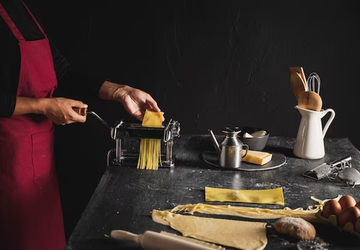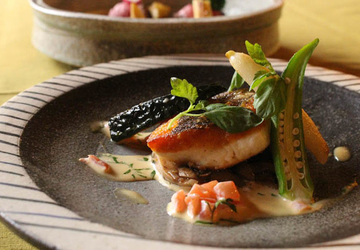Understanding the Basics: A Tour Through French Cuisine
At the heart of French cuisine lies a deep appreciation for the quality of ingredients and the art of careful preparation. French dishes are often built around a central ingredient, showcasing its flavors rather than overwhelming them. Seasonality plays a critical role, with menus adapting to the freshest produce available. This respect for the natural taste and quality of ingredients is what sets French cuisine apart and is the first principle in this beginners guide to French cuisine.
Stocking Your Pantry: The French Chef's Toolkit

A French chef's pantry is a testament to the cuisine's diversity and depth. Stocking up on a variety of herbs like thyme, rosemary, and tarragon is essential, as these are frequently used to impart subtle flavor to dishes. High-quality butter, creams, and a selection of cheeses such as Gruyère, Roquefort, and Brie are indispensable for creating the rich, comforting dishes France is known for. Lastly, no French pantry is complete without good wine, both for drinking and cooking, adding depth and flavor to sauces and stews.
Chapter Two: Mastering French Cooking Techniques
Knife Skills: Precision in Preparation
French cuisine demands precision, and it begins with your knife. The classic cuts—julienne (matchstick), brunoise (diced), and chiffonade (shredded)—are not just about technique but also about creating a uniform cooking experience, where each ingredient cooks evenly and contributes to the overall dish.
Sauces: The Heart of French Flavor
Mastering the mother sauces opens up a world of French cooking. Each sauce serves as a starting point from which numerous derivatives can be created. For instance, from béchamel, one can easily venture into making Mornay by adding cheese, or transform velouté into a supreme sauce with the addition of cream. The versatility of sauces in French cuisine cannot be overstated—they serve as the foundation for many classic dishes and can be a creative outlet for the home chef.
Baking: The Delicate Dance of Pastry
The precision and patience required for French baking are unmatched. Techniques such as the proper folding of dough for croissants or the gentle incorporation of air for a light and spongy génoise cake are paramount. Baking is a science and an art in French cuisine, requiring both strict adherence to recipes and a touch of personal flair.
Chapter Three: Easy French Recipes to Try at Home
Starting Simple: Soups and Salads
A simple leek and potato soup or a classic Lyonnaise salad with frisée and a poached egg can be an excellent start for beginners. These dishes allow home chefs to practice their skills while producing comforting and flavorful meals.
The Main Event: Classic Entrées Made Easy
Demystifying the classics is key in French cooking. A simplified bouillabaisse, where the essence of the Mediterranean is captured in a tomato-based fish stew, or a rustic ratatouille, where vegetables are the star, can be both approachable and deeply satisfying for the home chef to create.
Sweet Finishes: Desserts to Delight
French desserts can be as simple as a fruit clafoutis, where cherries are enveloped in a pancake-like batter, or a chocolate fondant with a molten heart. These desserts are not only crowd-pleasers but also serve as a great way to practice fundamental baking techniques.
Chapter Four: Bringing French Cuisine to Your Table
Pairing and Presentation: The Final Touches
The French take great pride in the presentation of their food. Learning how to plate dishes, garnish, and serve them can enhance the dining experience. A well-paired French wine can complement the flavors of the dish and elevate the meal to an authentic French dining experience.
Hosting a French Dinner Party: Tips and Tricks
Organizing a French dinner party can be the ultimate application of your new skills. Planning the menu around a theme, perhaps a region of France or a specific set of ingredients, can add coherence to your meal. Tips on décor, such as creating a simple yet elegant table setting, and advice on timing the preparation of dishes will ensure your gathering is as enjoyable for you as it is for your guests.
Beyond Recipes: Embracing the French Culinary Mindset

French cooking is a mindset—an embrace of the process, a respect for the ingredients, and a commitment to excellence that goes beyond following a recipe. It's a culinary philosophy that values quality over quantity and tradition alongside innovation.
Embarking on the path of French cooking is to walk in the footsteps of culinary giants. It’s an adventure that goes beyond mere recipes and ingredients; it’s about embracing a culture that has prized gastronomy as an art for centuries. Every time you tie your apron, you’re not just preparing a meal, you’re weaving a narrative that extends from the bustling Parisian cafés to the tranquil Provencal countryside, where the essence of French cooking lies in every herb-infused breeze and sun-kissed vineyard.
As you progress from mastering the rustic charm of a hearty boeuf bourguignon to the delicate balance of a soufflé, you’ll discover that French cooking is an endless journey of learning and pleasure. Each recipe is a chapter in a story that tells of tradition, innovation, and the celebration of life’s simple joys. It’s about gathering friends and family, about the laughter and conversations that dance around the dinner table as much as it’s about the food that graces it.
The beauty of French cuisine lies in its ability to be learned over a lifetime. Every success, be it the perfect golden crust of a baguette or the rich reduction of a Bordeaux wine sauce, is a milestone in this lifelong culinary quest. And with every challenge, like the intricate layers of a mille-feuille or the precise timing of a duck à l’orange, comes the opportunity to grow and revel in the satisfaction that only comes from creating something truly exquisite. French cooking isn’t just a skill—it’s a living, breathing art form that you get to be a part of, one sumptuous meal at a time.
Conclusion: Your French Cooking Journey
Your journey through French cuisine will be filled with discoveries and delights. As you employ French cooking techniques for home chefs and explore easy French recipes to try, your skills will grow, and so will your appreciation for one of the world's most esteemed culinary traditions.
-
Chickpea Flour: The Versatile Ingredient Changing Gluten-Free Baking
Chickpea flour has gained momentum in gluten-free baking, offering a nutritious and flexible alternative to traditional flours. This flour is becoming a staple ingredient for those who follow gluten-free diets, providing a way to enjoy familiar baked goods without compromising taste or texture. Its growing popularity is driven by the increasing demand for gluten-free options and the desire for more nutrient-rich ingredients in daily cooking.
-
How to Cook Homemade Meals for Your Pet: Top 10 Tasty Treats
We all want the best for our furry friends, and one way to show them some extra love is by whipping up some homemade pet treats. Not only are they delicious, but they also allow you to control what goes into your pet's diet. No more worrying about mysterious ingredients or preservatives. In this guide, we'll share our top 10 tasty homemade treats that your pet will drool over. And don't worry, you don't need to be a master chef to make these – they're simple, wholesome, and fun!
-
Upgraded Comfort Foods: Classic Dishes With A Gourmet Twist
Comfort food has always been synonymous with feelings of warmth, nostalgia, and simplicity. These dishes take us back to moments shared with family or childhood favourites that have become staples in our kitchens. However, in recent years, the culinary world has seen a rise in reimagined versions of these classics. Combining the rich flavours we love with gourmet techniques and ingredients, these dishes offer a modern take on timeless comfort food.